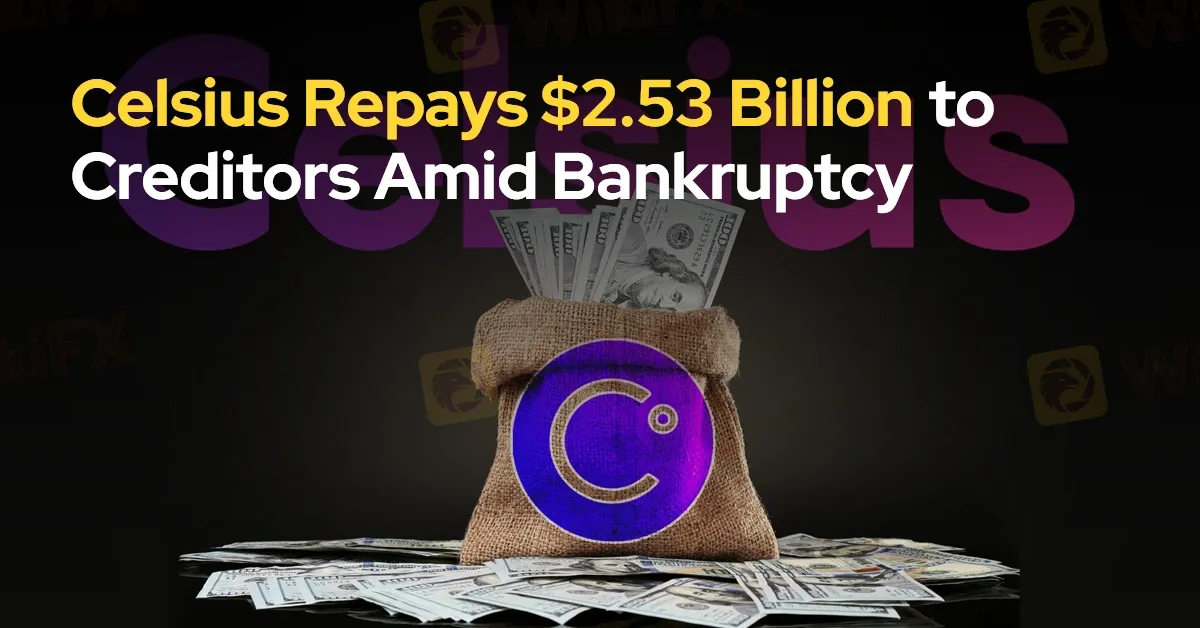简体中文
繁體中文
English
Pусский
日本語
ภาษาไทย
Tiếng Việt
Bahasa Indonesia
Español
हिन्दी
Filippiiniläinen
Français
Deutsch
Português
Türkçe
한국어
العربية
Celsius Repays $2.53 Billion to Creditors Amid Bankruptcy
Abstract:Bankrupt crypto lender Celsius has made significant progress in its ongoing bankruptcy proceedings by repaying approximately $2.53 billion to 251,000 creditors.

Bankrupt crypto lender Celsius has made significant progress in its ongoing bankruptcy proceedings by repaying approximately $2.53 billion to 251,000 creditors. This repayment accounts for roughly 84% of the $3 billion in assets owed to over 375,000 creditors, according to recent court filings.
Despite this substantial repayment, the process has not been without complications. Not all creditors are actively pursuing their claims, particularly those owed smaller amounts. The court filing reveals that out of the remaining 121,000 creditors, around 64,000 are owed less than $100 worth of cryptocurrency, while 41,000 have claims ranging from $100 to $1,000.
The bankruptcy administrator has been systematically distributing funds to eligible creditors, utilizing Coinbase for bi-weekly distributions. In addition, PayPal claim codes are available for redemption at any time. The administrator reported over 2.7 million distribution attempts to approximately 372,000 eligible creditors, demonstrating the scale and complexity of the repayment process.

However, disputes have arisen, particularly from corporate creditors who feel they have been treated unfairly. In July, a married couple holding corporate accounts with Celsius, Sheri Anne Faller and Bernard Jacob Faller, filed for a second payout, claiming that their repayment was reduced by 35% compared to non-corporate accounts. The couple's Individual Retirement Accounts (IRAs) held over $1 million in cryptocurrency before Celsius's bankruptcy filing. According to the bankruptcy plan, their claim was reduced to $634,337.93, which included 7.38 BTC and 123 ETH, scheduled for payout on January 16.
Adding another layer of complexity to Celsius‘s bankruptcy proceedings is a lawsuit filed by the defunct lender against Tether, the company behind the leading stablecoin USDT. Celsius is demanding the return of 57,428.64 Bitcoin (BTC), valued at approximately $3.3 billion, alleging that Tether engaged in “preferential and fraudulent transfers” during the market downturn in mid-2022. Tether, however, disputes these claims, asserting that the Bitcoin was sold at Celsius’s instruction and with its consent. Tether‘s CEO, Paolo Ardoino, labelled the lawsuit as meritless and vowed to defend against it vigorously. The outcome of this legal battle could further impact the already complex and contentious proceedings surrounding Celsius’s bankruptcy.
Despite this agreement, the Celsius debtors allegedly missed the payment deadline. The couple was informed on January 19 that they would not receive cryptocurrency payments because their accounts were not among the top 100 corporate accounts by asset value. Instead, their cryptocurrency was converted to cash and paid out through the banking system. Although the couple agreed to the cash settlement, they claim the payment was not made promptly. They received a wire transfer of $414,733 on February 22 but could not access the funds until March 8. Additional payments totalling $219,602 were received on April 22, bringing the total to $634,335.
The couple argues that the cash value received was significantly less than the value of the BTC and ETH they were owed, based on the cryptocurrency prices on the payment dates. They assert that they should have received $973,955 and are demanding an additional $338,611 plus $11,984 in interest for holding their cryptocurrency beyond the required distribution date, amounting to $350,596 in total.
Other corporate creditors have echoed similar complaints, alleging delayed payments and cash settlements instead of cryptocurrency, leading to further financial losses. In March, another corporate creditor claimed to have received 30% less than the agreed amount under the bankruptcy plan.
Celsius defended its actions by stating that it had sold the users cryptocurrency on January 16 as required by the bankruptcy plan and therefore could not pay in crypto that it no longer held. The estate further claimed that corporate accounts faced a more stringent compliance and onboarding process, which hindered the ability to secure accounts for most corporate creditors.
As Celsius continues to navigate its bankruptcy proceedings, these disputes highlight the challenges and complexities involved in resolving claims in the volatile cryptocurrency market. The outcome of these disputes, alongside the lawsuit with Tether, could have significant implications for other creditors still awaiting their repayments.

Disclaimer:
The views in this article only represent the author's personal views, and do not constitute investment advice on this platform. This platform does not guarantee the accuracy, completeness and timeliness of the information in the article, and will not be liable for any loss caused by the use of or reliance on the information in the article.
Read more

Terraform Labs Co-founder Do Kwon Extradited to the U.S. to Face Fraud Charges
Montenegrin authorities have transferred Do Kwon, co-founder of Terraform Labs, to the United States, concluding an extended legal battle over his extradition

Bithumb CEO Jailed and Fined Over Bribery Scheme in Token Listing Process
Lee Sang-jun, the former CEO of Bithumb, South Korea’s largest cryptocurrency exchange, has been sentenced to two years in prison and fined 52 million won ($35,367) for his involvement in a bribery scheme that manipulated the platform’s token listing process.

MoonPay Among the First Companies Approved Under MiCA Regulation
MoonPay receives MiCA license in the Netherlands, enabling EU operations under stricter regulations.

China's New Forex Rules Target Cross-Border Crypto Trading
China's new forex rules tighten monitoring of cross-border crypto trades, requiring banks to track identities, fund sources, and trading frequencies.
WikiFX Broker
Latest News
WikiEXPO Global Expert Interview: Loretta Joseph——Unlock the forefront of digital finance
Vietnamese Police Bust $1.2 Million Crypto Fraud Case
XTB Receives Licenses to Operate in Indonesia & UAE
SEBI Bans Big "Finfluencers for Misleading Investors"
WikiFX New Year Bash: Chance to Win 70 USDT
Will Gold Break $2,625 Amid Fed Caution and Geopolitical Risks?
ECB Targets 2% Inflation as Medium-Term Goal
New Year, New Surge: Will Oil Prices Keep Rising?
Will Gold Shine Brighter in 2025?
WikiFX Review: Is HYCM still reliable in 2024?
Currency Calculator






